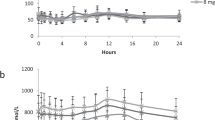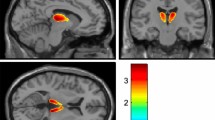Abstract
L-DOPA (3, 4-dihydroxyphenylalanine) has, since 1967, been used in large doses clinically to lessen the degree of akinesia, rigidity and tremor in Parkinson's disease1. The impetus for dopa therapy came from the discovery of abnormally small concentrations of dopamine in the basal ganglia of patients with Parkinsonism2. Since catecholamines cannot cross the blood-brain barrier, dopa, the immediate metabolic precursor of dopamine, became the logical candidate for clinical trials. Administration of dopa increases dopamine in the basal ganglia3, and this is believed to be the primary mode of action of the drug. Although partially correct, this cannot account for the so-called on–off effect4—the increase in therapeutic benefits derived from prolonged use of dopa5—and side effects such as nausea, vomiting and personality disturbances. The latter are minimised by simultaneous administration of decarboxylase inhibitors which limit peripheral decarboxylation and allow smaller doses of dopa to be effective. Nonetheless it seems that the action of dopa is complex, with several mechanisms operative. It is therefore important to elucidate all possible metabolic fates of dopa and consider their relationship to the various effects of dopa. We report here in vitro evidence for a minor pathway of dopa metabolism resulting in the formation of 3,4-dihydroxy-phenylacetaldehyde (DHPA) with concomitant inactivation of dopa decarboxylase.
This is a preview of subscription content, access via your institution
Access options
Subscribe to this journal
Receive 51 print issues and online access
$199.00 per year
only $3.90 per issue
Buy this article
- Purchase on Springer Link
- Instant access to full article PDF
Prices may be subject to local taxes which are calculated during checkout
Similar content being viewed by others
References
Cotzias, G. C., van Woert, M. H., and Schiffler, L. M., New Engl. J. Med., 276, 374–379 (1967).
Ehringer, H., and Hornykiewicz, O. Klin. Wschr., 38, 1236–1239 (1960).
Davidson, L., Lloyd, K., Dankova, J., and Hornykiewicz, O., Experientia, 27, 1048–1049 (1971).
Barbeau, A., Neurology, Minneapolis, 22, 22–24 (1972).
Cotzias, G. C., Papavasiliou, P. S., Steck, A. and Duby, S., Clin. Pharmac. Ther., 12, 319–322 (1971).
Pletscher, A., Adv. Neurol., 3, 49–57 (1973).
Sourkes, T. L., Archs Biochem. Biophys., 51, 444–456 (1954).
Voltattorni, C. B., Minelli, A., and Turano, C., FEBS Lett., 17, 231–235 (1971).
Huntley, T. E., and Metzler, D. E., Abstracts, 154th National Meeting of the American Chemical Society,Chicago, 201C (1967).
Sukhareva, V. S., and Braunstein, A. E., Molec. Biol. USSR, 5, 302–317 (1971).
Christenson, J. G., Dairman, W., and Udenfriend, S., Archs Biochem. Biophys., 141, 356–367 (1970).
Lancaster, G. A., and Sourkes, T. L., Can. J. Biochem., 50, 791–797 (1972).
Kirby, G. W., and Ogunkoya, L., J. chem. Soc., 6914–6922 (1965).
Fellman, J. H., Nature, 182, 311–312 (1958).
Author information
Authors and Affiliations
Rights and permissions
About this article
Cite this article
O'LEARY, M., BAUGHN, R. New pathway for metabolism of dopa. Nature 253, 52–53 (1975). https://doi.org/10.1038/253052a0
Received:
Revised:
Issue Date:
DOI: https://doi.org/10.1038/253052a0
Comments
By submitting a comment you agree to abide by our Terms and Community Guidelines. If you find something abusive or that does not comply with our terms or guidelines please flag it as inappropriate.



